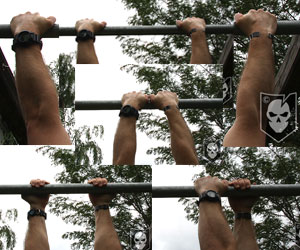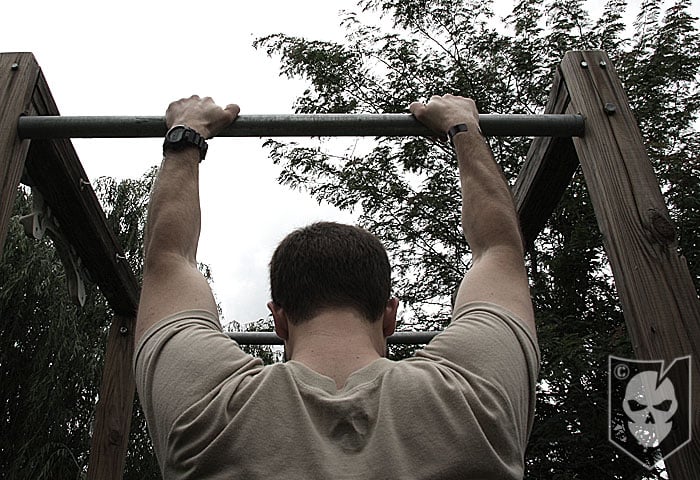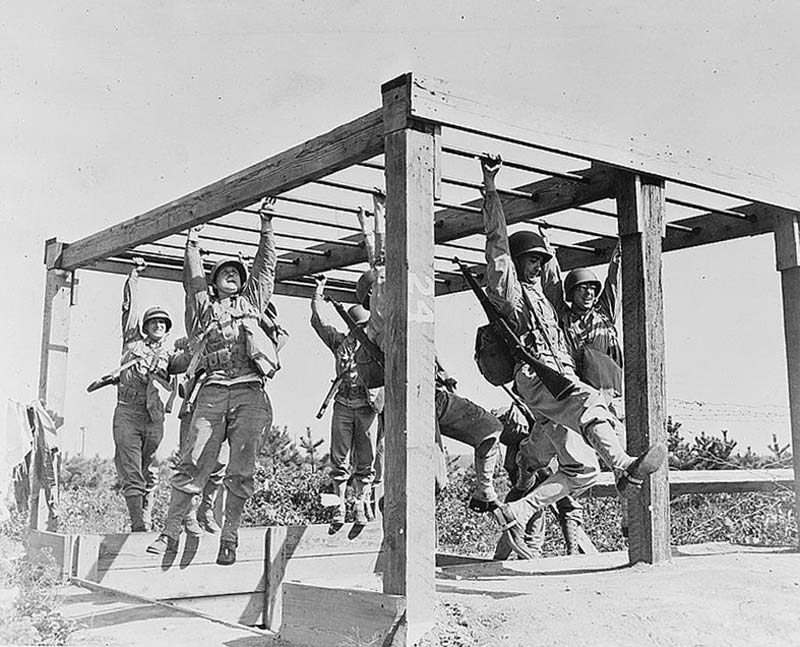Functional Strength: Developing the Pull-Up
Functional Strength: Developing the Pull-Up
We’ve recently talked the importance of physically being able to save yourself, and one of the most important aspects to this is upper body strength and the pull-up.
Again, functional strength movements are movements the body makes naturally. Let’s talk realistically here for a second, is the guy that grunts and groans way to loudly while bench pressing 400 lbs. going to be able to climb a rope? Probably not unless he’s devoting some time to working on his functional strength.
Is that ogre going to be able to get his ass over a wall in a hurry? Again, probably not. Now don’t let size fool you because I’ve seen some pretty huge dudes able to do 20+ pull-ups. It all comes down to one thing, practice. Yes, practice. There’s no pill, shake or other dietary crap that will help you here, despite what infomercials say. Having good functional upper body strength is what’s going to help pull you out of harms way. The bench press is dead to me.
Before I go any further, I’ve been doing pull-ups now for a very long time and have a lot of time invested into technique and mastering the pull-up. When I started though, I couldn’t do one. Now on a good day I can hit around 24, but there was a time when I could do 30. I say that because it’s all about repetition and practice, your numbers will be directly proportional to your time spent training.
Mine have decreased because of the frequency I do pull-ups now. I’m not actively training for a program or a standard that i’m trying to meet, so for me right now its about maintenance. This article though will give you some good techniques to develop your pull-up whether your goal is good functional strength, or to crush the next Military Fitness Test.
Proper Technique
When we’re talking about pull-ups in this article, we’re talking about grabbing the bar with your palms facing out, thumbs next to your index fingers, arms shoulder width apart, starting from a dead-hang position (arms fully locked out) and pulling yourself up until your chin is over the bar. Coming back to a dead-hang before starting the next rep is also proper form.
You should always focus on looking up at the bar to help lift your chin over the bar and to also help to activate your shoulders. Active shoulders start from the beginning of the movement and the video below will help you understand what active shoulders means. The video also explains how your elbows tuck behind your body helping to open your chest and propel you further up and over the bar.
Let’s deviate for a second and I’ll explain what a pull-up is not. A pull-up is not done by bending your legs while hanging and using momentum to carry you over the bar. A pull-up is not using a swinging motion to propel you over the bar. A proper pull-up is not done by kipping, despite what CrossFit says.
I’m a CrossFit Certified Level 1 Instructor, and you’ll never hear me say that a kipping pull-up counts. Yes, after getting out of the service I was naive enough to try to implement them, but quickly dismissed them as a real pull-up. If you know anything about some of the ridiculous times that people claim to do workouts like “Fran” in, go watch the YouTube videos of what their pull-ups look like.
Here’s a demonstration video I put together for this article:
Negatives
If you’re starting with nothing, can’t do one pull-up, think you’re too overweight to try, think again. It’s never too late to start developing functional strength because your body is already making these movements, you just have to build on them. Having a ton of extra weight around is never a good thing, and obviously you’re going to be working harder than you should.
For starters, you can do negatives, negatives will help your arms get used to supporting the weight of your body. To do a negative, stand on something or get a friend’s help to get your chin over the bar. Once you’re holding that position, slowly lower yourself down until you’re in the the dead-hang position. It’s important that you not come down to quickly either, shoot for about 5 or 6 seconds.
If this is all you can physically tackle, then stick with negatives. If you’re not able to last 5-6 seconds coming down, let that be your goal. You have to set small goals for yourself, and building on those is what’s important.
You should be working on pull-ups at least 3 times a week, and it’s important to give your muscles time to recover between pull-up days. For negative workouts, again you’re building so start small. Go for two sets of 10 three times a week.
Assisted Pull-Ups
No, I’m not talking about that pull-up machine in the gym or lat pulldowns. Neither of these will replicate the natural movement and balance your body has to have while doing a pull-up. The assisted pull-ups best for replicating the true pull-up form are either a friend pressing-up/holding the toes of your feet, or finding a low hanging-bar and pulling yourself up.
There are also big rubberbands that can be girth hitched onto a bar and you can stick your feet in to assist you. Again, I’m not a fan of these because they are a crutch and not letting the body balance on its own.
When a buddy holding your feet there’s still a pivot point where some balance is lost, but not the same as with the other assisted methods. It’s important that while I say “holding your feet,” your buddy really isn’t holding your feet. Really they’re just providing a surface to give you some lift from and not trying to grasp and stabilize your feet.
The low-hanging bar can be anything 3 to 4 feet above the ground that you grab and lift yourself up to. It’s important here to bend your legs behind you and pivot off your toes as you come up, not press off your toes. The assist comes from the decreased height, not the lift from your feet.
Pyramids
 Once you’re able to successfully complete a pull-up, it’s time to really start increasing your numbers. There are a few workouts I’ve always followed that have helped me along the way.
Once you’re able to successfully complete a pull-up, it’s time to really start increasing your numbers. There are a few workouts I’ve always followed that have helped me along the way.
A pyramid workout is very simple, yet powerful. If you look at the diagram to the right you’ll see a series of numbers increasing up the left side of the pyramid and decreasing down the right side of the pyramid. These are the repetition numbers. So in the case of this pyramid workout, you’d do 1 pull-up, rest, 2 pull-ups, rest, 3 pull-ups, rest, etc. When you reach the top, you start falling back down the pyramid with 4, 3, 2 and then back to 1 pull-up.
A good rest period to start out with is 1 minute to 1:30. The pyramids can be as easy or complex as you’d like, and just to give you an idea, I typically do a 1-10-10-1 pyramid or 2-4-6-8-10-10-8-6-4-2 repeating 10 at the top.
Obviously again the importance here lies with building. Don’t put your max rep number at the top of the pyramid, you’ll never make it up and down. By the time you’ve done a complete cycle of the 1-10-10-1 pyramid, you’ve knocked out 110 pull-ups. Not too shabby for a pull-up workout. It takes time to get there though, so don’t get discouraged.
Different Grips
 A second workout I do is almost like a mini pyramid but using the five different kinds of pull-up grips. These are regular, reverse (chin-up), close, wide and commando (or mountain climbers).
A second workout I do is almost like a mini pyramid but using the five different kinds of pull-up grips. These are regular, reverse (chin-up), close, wide and commando (or mountain climbers).
Using a 2-4-6-8 pattern, you do that for each of the five grips. So regular 2-4-6-8 then once finished with regular grip, you move on to reverse grip and do 2-4-6-8, etc. This workout also gives you 100 pull-ups total, but can be scaled up or down very easily. Simple doing a 2-4 with each of the five grips is a great way to start.
Lately I’ve been sticking with the 2-4-6-8, but can be bumped to 2-4-6-8-10 or 2-4-6-8-12 if you’re feeling frisky.
Notes
I definitely can’t take credit for designing these workouts. They were first shown to me by Stew Smith’s 12-Weeks to BUD/s book which I used to follow religiously. These are great foundational programs for increasing your pull-ups and I’ve had a lot of success with them over the years.
I also want to mention that these workouts are not just for guys, women can also show tremendous gains using these workouts and not worry about looking like the cover of muscle magazine. Functional strength is for everyone and should not be overlooked in planning your fitness goals.
How do you guys implement functional strength training? Do you have a favorite pull-up workout?
Click here to view the photo set on Flickr.
[flickrset id=”72157624135080278″ thumbnail=”square” overlay=”true” size=”medium”]











Discussion